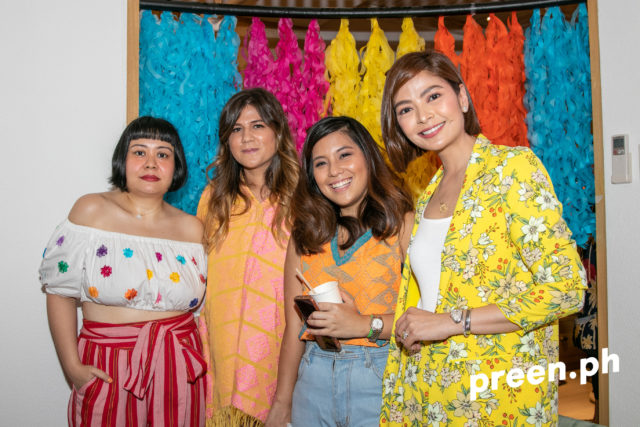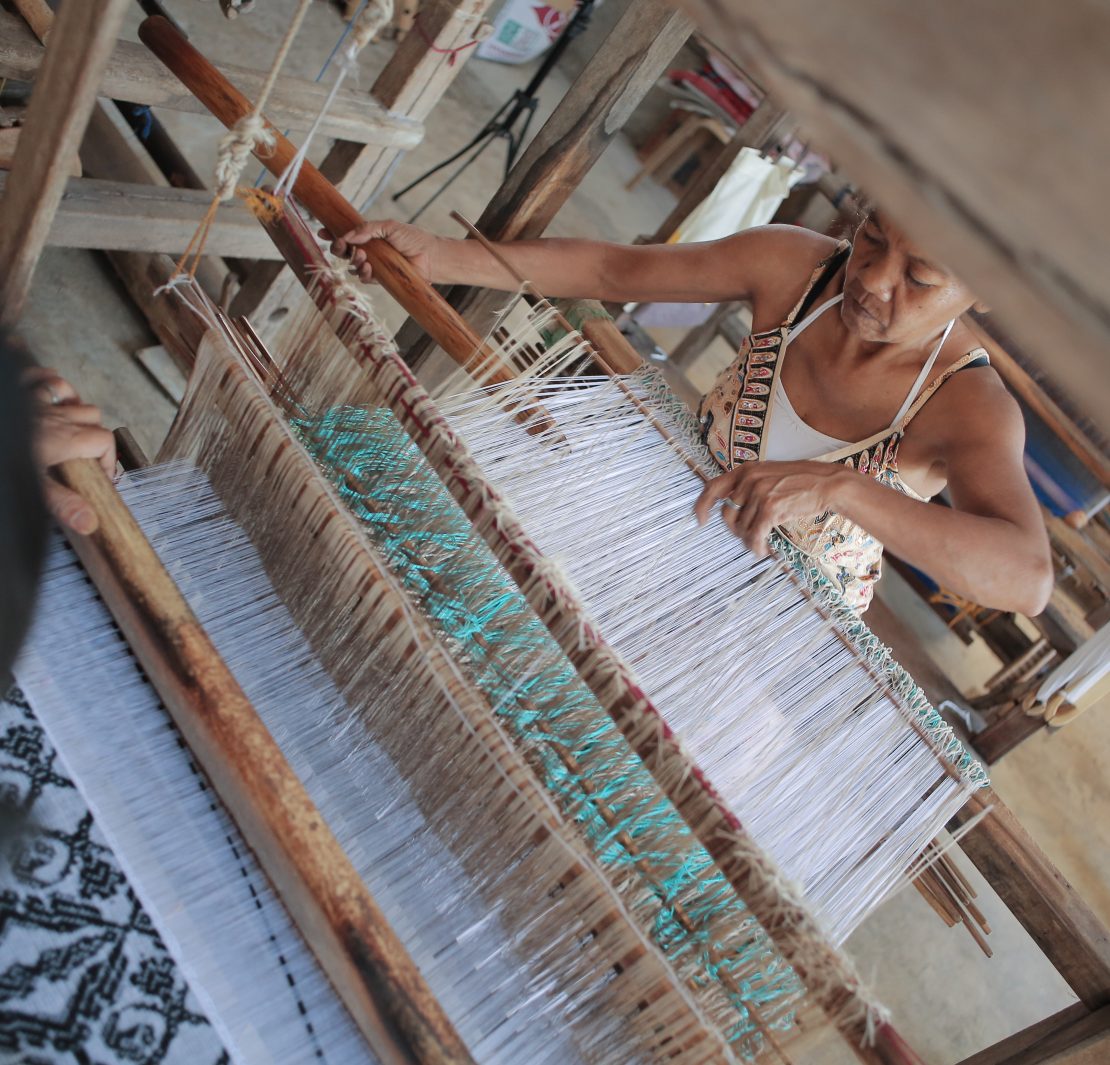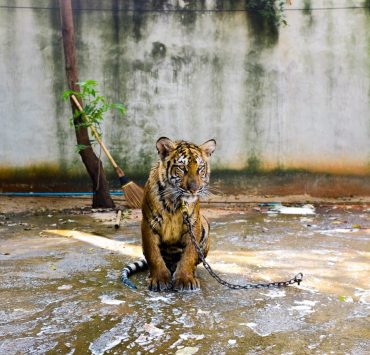If you’re an eagle-eyed consumer, you’d have probably noticed that there’s a growing interest in the local trade industry for distinctly Filipino products: inabel weaves, rattan chairs, you name it. The tide is turning, this time in favor of homegrown, so to speak.
However, there is a dark side to this. As shown in the recent debacle with the streetwear brand that used Kalinga designs purportedly with Whang-Od’s permission, many brands are willing to exploit different IP groups and appropriate cultural designs for a quick buck. [Read: Underpaid and unacknowledged: The current state of Filipino weavers]
We talked to Paloma Urquijo Zobel, founder and creative director of Piopio, about this renewed interest in local ware, the brand’s relationship with weavers, and her plans for the future.

How did you first come in contact with the inabel weavers?
It was never really in the plans and it all happened by a wonderful coincidence. My background is actually in marketing and strategic design but I was doing some research and working on building up the foundation for Kalye Artisano, our artist village in El Nido. While researching and traveling around the Philippines, I kept seeing these beautiful textiles and weaves and it triggered a pretty strong emotion in me. I have cousins from Colombia and friends from Mexico and Peru who wear amazing artisanal products daily, and after seeing that we could produce equally as beautiful and unique textiles, I took it upon myself to join in on this movement of making these local textiles relevant again.
In the age of instant gratification, advanced machinery and 3D printing, imagine how hard it is to justify to a new generation the importance of sitting on a loom for around one month to produce a single blanket versus pressing a button on a machine to produce immediate results. To me, this was a really important challenge—How do we continue to create demand for these hand made blankets? How do we ensure that the history and identity being passed on through this craft continues to be relevant to the next generation?
To truly embrace this challenge, I had three goals in mind: remove any past negative perceptions or associations people had of inabel; build awareness around the process of making these weaves and the history they carry; and make these weaves relevant.
To do this, I set out to create a lifestyle brand.
I wanted to promote and encompass a way of life and certain values. It wasn’t just about the final product; it was about promoting Filipino craft and artistry and keeping these traditions alive. I revisited my three goals again and decided that my first step would be to rebrand the image of inabel and create a clothing line that re-imagined a use for these blankets. By doing this I would be able to ensure relevance, and as a result, introduce a product that would allow people to enjoy this beautiful craft on a daily basis.
How much collaboration is involved between you and the weavers when designing a product? Can you explain the process?
From the beginning, we always made it a point to harness strong relationships with our weaving communities and visited them regularly but the relationship at the start was more of a simple transactional basis. We did not want to interfere with the traditional technique or process, so the weavers would dictate the mood of the collection. I’d purchase what they would create and base the design off the finished product rather than the other way around. I would let the textile inspire the collection to help showcase the artistry as much as possible.
This year, we changed the process. The weavers were becoming more and more interested in expanding their product range so we sat with them to see how we could collaborate to work more closely. We have been working on expanding the range of colors and patterns used as well as testing different cottons for maximum efficiency and sustainability.

When we talked to the Habi Fair coordinators last year, we learned that many weavers still largely go underpaid and underacknowledged even when they’re working for big fashion houses. How do you ensure the protection of the inabel weaver communities that you work with?
Piopio has and will always be a social enterprise above anything else. Any profit made goes directly back into the company, into product development, or into bettering the conditions of the weavers. We founded Piopio because we knew that it was a project that could enrich lives and create long lasting livelihoods for many, if done right, which eventually could translate into profit for everyone.
While other fashion houses, brands, and curators might not share the same values and use the opportunity working with the weavers to turn a quick profit at the expense of the community, we see the value in harnessing such traditions and techniques and the best we can do this, is by empowering these weavers and educating buyers to ensure they are supporting the proper causes.
We were told that you’ve been working on “developing color combinations and undertaking various means of updating inabel weaver communities” for the better half of this year. Can you elaborate on that?
Our first goal for Piopio was to bring awareness to the weavers of the Philippines, and we did this by creating a fun and young clothing line that would allow for Filipinos to wear their homegrown textiles as everyday wear. Three years on, we believe that with the help of similar advocacies, our generation is celebrating these textiles and they have become more popular than ever before.
Our next step was to ensure the steady supply and demand of these fabrics by also helping the weavers with product development and equipping them with business tools. Typically, the weavers worked with colors they would see around them, mainly the primary colors, to create the blankets—so we began working with them to introduce new color combinations and palettes by creating special color guidelines that the weavers could use as reference. We also supplied the test thread for prototypes.
Also, as is the practice of any fashion brand when working with suppliers, we ask all the weavers we work with to keep these designs exclusively for Piopio for one year, before selling them to other buyers or designers. As Piopio is in a very competitive industry, it is not unheard of to encounter corporate or creative espionage—as much as possible we want to protect our weavers from such practises, and protect the integrity of our brand as well. Once the year lock-out has lapsed, the weavers are free to sell the designs as they choose.
How do you manage navigating the line between updating weaves and censuring their culture? It sounds like, in the wrong hands, it could very much lead to cultural appropriation.
I actually appreciate the conversations that have arisen in recent years around this topic. Piopio is extremely proactive in involving the communities from whom we source in our process, and we organize immersive experiences with these communities with the whole team so we understand we who we are working with and how best to highlight our culture and heritage.
I do, however, always stand by the fact that we celebrate culture appreciation. We do a lot of research beforehand and throughout the process as well, always highlighting that the main element of all our pieces are the textiles we purchase from these communities. We never replicate, we work with the original artisans to ensure their livelihood, tradition, and heritage carries on.
My aim for Piopio is to shine a light on Filipino culture, and make traditional textiles relevant to younger generations. Our challenge daily, is to stay truthful to our culture and traditions without offending anyone but still making our pieces relevant and more accessible to a new generation.
We feel that by allowing these textiles to take on more current shapes, forms and colors, we are helping them to be enjoyed and shared by more individuals, than would be otherwise. We repurpose these textiles in the spirit of respect, and in an effort to keep our traditions alive and more relatable, while supporting our artisans and ensuring that their craft lives on.

When you started PIOPIO, the idea of using indigenous Filipino textiles, while not unheard of, was not something that a lot of brands did. But since then, there’s been a huge boom for local textiles. How has this affected the weavers?
I have seen a lot of positive changes, the most noticeable would probably be the fact that when I went on my first sourcing trip to Ilocos in 2015 and visited a weaving community, there were only two female weavers and both above the age of 50. When I returned in March of 2019 to the same community, we counted a total of 12 weavers, both male and female and even kids who would join in to help out after school. The atmosphere had changed and there was a strong sense of pride in the air and that’s just one of the communities we work with but I’ve seen the same trend throughout. A large surge in weavers as a means of livelihood.
The other major change which is also a great representation of this new demand and surge of local textiles, is the way in which the weavers now conduct their businesses. In 2015, many of the weavers we worked with did not even know their worth and it was evident to us that they had been taken advantage of by middle men. We did our best to educate them on the correct pricing and empowered them to take a stand and defend this time consuming craft that they work so hard on.
Originally the weavers produced the blanket and took care of sales. Today, we have seen them delegate the task of marketing and sales to their kids or family members, most of which are millennials and now rely on their phones to market and sell which allows them to broaden their clientele and allows for more platforms to sell their products so they have more wiggle room and confidence to experiment with pricing as well as to see the large demand for themselves
What’s ultimately your goal for Piopio and the inabel weavers?
For Piopio it will always be to carry on showcasing and celebrating Filipino culture and artistry and we can only do this by ensuring the future of the artisans we work with and ensuring they pass on these traditions and cultures to future generations.
Answers have been edited for brevity.
Header photo courtesy of Piopio
Get more stories like this by subscribing to our weekly newsletter here.
Read more:
9 shops to buy inabel, a loom-weaved indigenous textile from the north
A quick guide to indigenous textile symbols
You can visit Intramuros’ museums for free on Oct. 27
Auro Chocolate serves chocolate turon pie at this cafeteria
Writer: ZOFIYA ACOSTA




